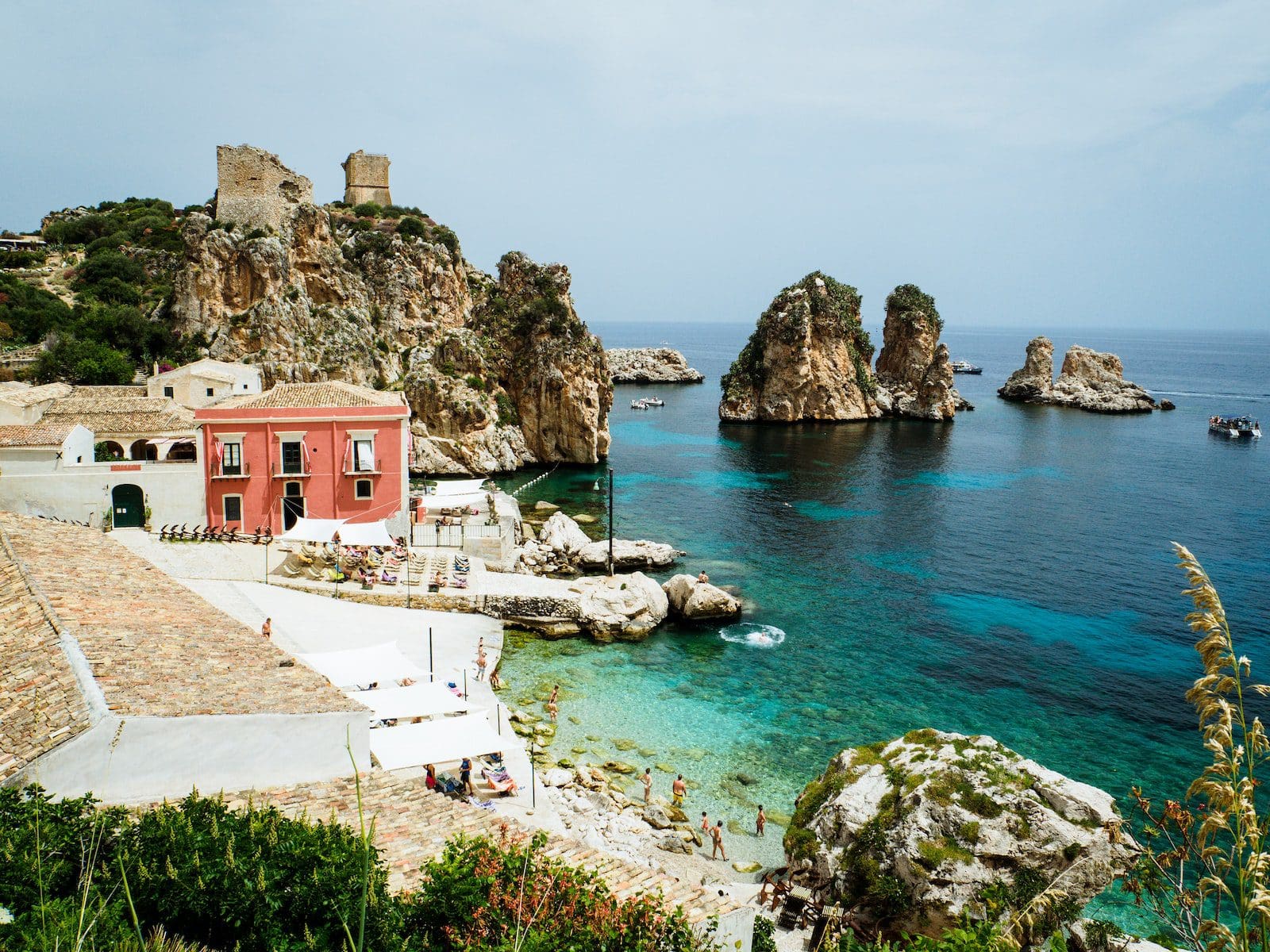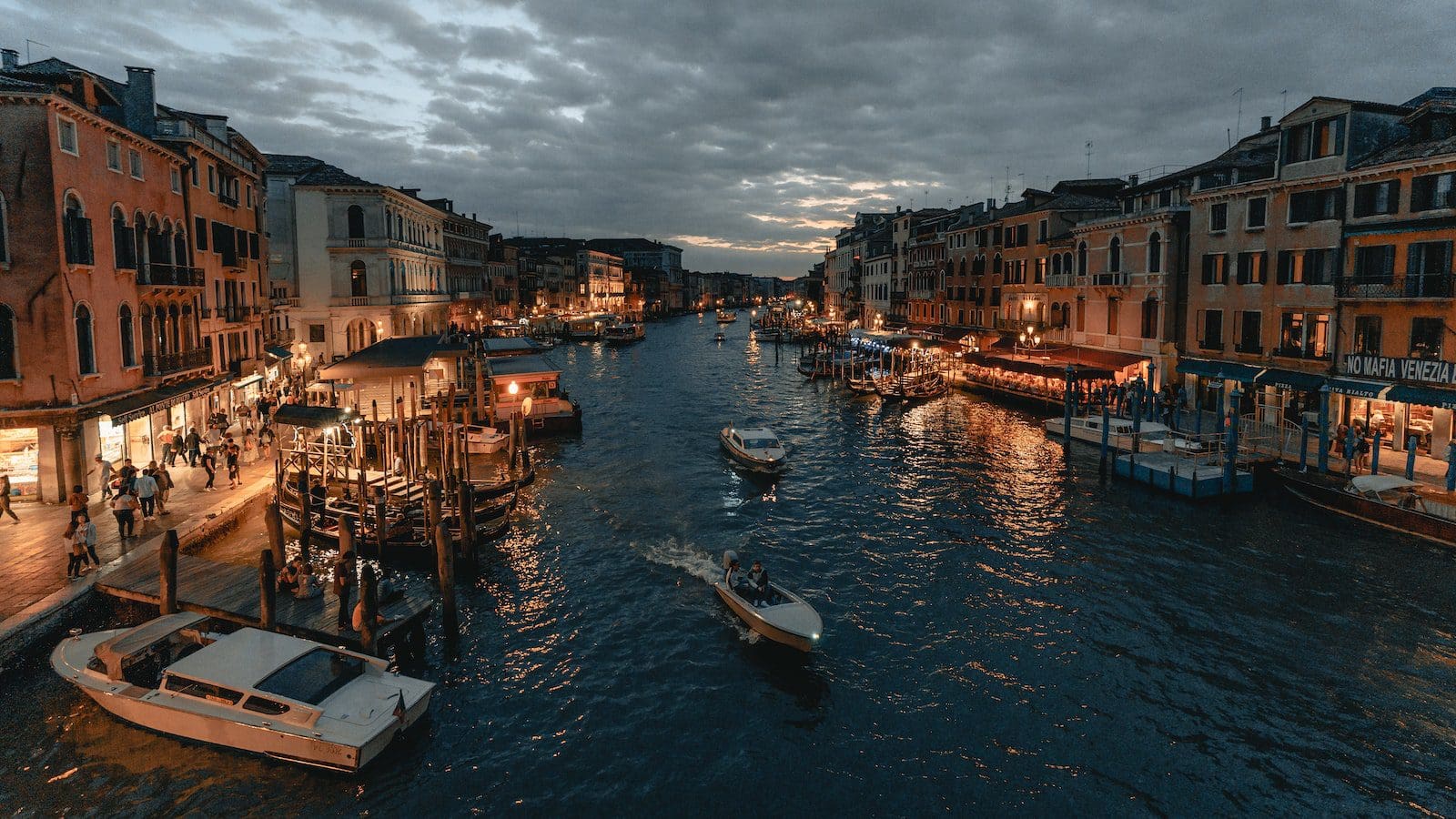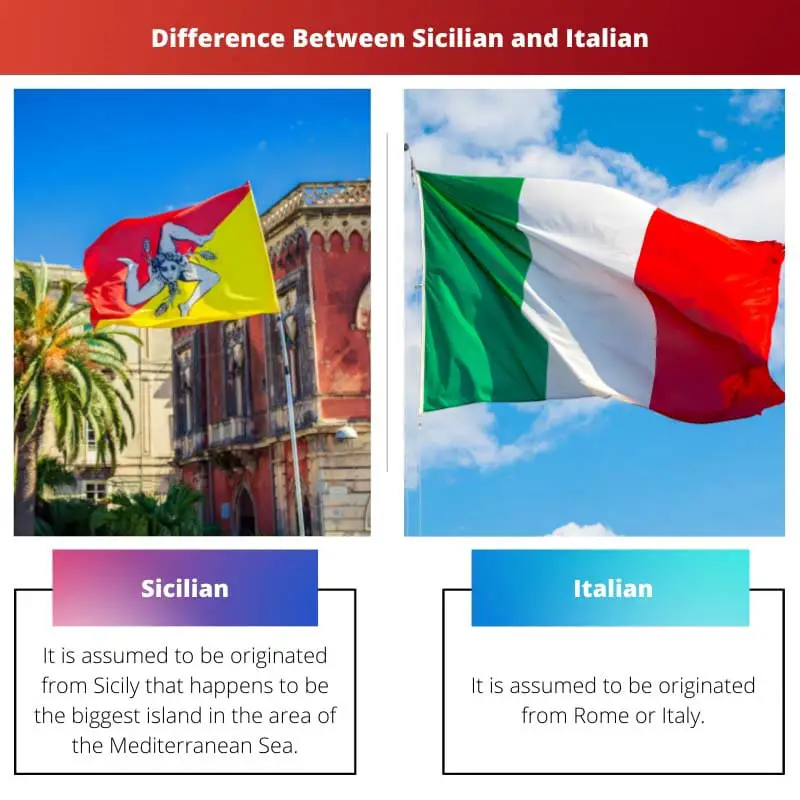Languages are essentially a man’s way of expressing himself. Without a language, it is not at all possible for someone to put forth his ideas, opinions, and thoughts in front of the whole world to listen.
On planet Earth, thousands of different languages are spoken, which are completely distinct, while some are almost identical to one another.
Not just for the sake of speaking but for awareness, it sometimes becomes crucial to differentiate between similar considered languages.
Sicilian and Italian are two such languages that are mostly considered similar by many people. But it is not true as these two differ from one another widely.
Key Takeaways
- Sicilian cuisine has been influenced by Arab, Spanish, and Greek cultures, while Etruscan, ancient Roman, and Byzantine cultures have influenced Italian cuisine.
- Sicilian cuisine includes seafood, eggplant, and citrus fruits, while Italian cuisine includes pasta, pizza, and tomato sauce.
- Sicilian cuisine is known for its sweet and savory flavors, while Italian cuisine is known for its simplicity and use of fresh ingredients.
Difference Between Sicilian and Italian
The difference between Sicilian and Italian is that the former happens to be a very less spoken language and is limited only to the island of Sicily and some other parts of Italy only. In contrast, the latter happens to be the third biggest of all the languages in the world and has gained a vast amount of fame with the passage of time. Not just this, but these two differ in terms of their origin, attributes, and other features too.

Sicilian is a language that has been reported endangered among many other languages by UNESCO itself. This language is seen only on the island of Sicily and among its people.
However, the people who have migrated from this island to other parts of the world also seem to have spoken this language among themselves as a traditional medium to communicate.
But for survival. Eben, they are forced to learn and speak other languages.
While Italian, on the other hand, is a very infamous language that requires no introduction. With almost a population of about 70 million people speaking it, it is considered the third biggest language among all other languages.
Basically, it happens to be a European language, but all other parts of the world have also adopted it in their cultural and academic teachings.
Comparison Table for Sicilian vs Italian
| Parameters of Comparison | Sicilian | Italian |
|---|---|---|
| Origin | It is assumed to be originated from Sicily that happens to be the biggest island in the area of the Mediterranean Sea. | It is assumed to be originated from Rome or Italy. |
| Official use | This language is not an official language of any part of the world, not even Sicily. | This is an official language in the following countries Italy, Vatican City, San Marino, Switzerland. |
| Spoken in | People of the island of Sicily and certain emigrants. | Majorly spoken in Europe but has spread in many countries, including the United States and Russia. |
| Spoken by | Almost by 5 million people only. | Almost 70 million people. |
| Status | It has been termed as endangered by UNESCO itself. | It has gained popularity day by day due to its world-famous progress. |
| Value | This language is considered as inappropriate or vulgar, and people criticize it. | This language is considered a language of arts, culture, and romance. It is very valuable in the eyes of the world. |
| Similar to | This language happens to be a similar form to Italian. | This language happens to be a similar form to Latin. |
What is Sicilian?
Said to be originated on a small island inside the boundaries of Italy, Sicilian is a language that resembles Italian in many aspects. But it only resembles, and in reality, many differences can be found.
Before the year 1861, Italy was divided into many tiny provinces and states, and each of those states had its own way of expressing itself.
After Italy became a unified country, they adopted Italian as the official language, but other languages like Sicilian lost their existence.
Talking about the language point of view, this language is different from other European languages in terms of grammar, punctuation, and many more.
But due to unfortunate circumstances, this language became obsolete, and UNESCO declared it endangered.
Today. Around 5 million people speak this language, and these people are located on the island of Sicily only. The government has not accepted this as an official language, and due to all this, this language is losing its figure each day.
Distinctive Features of Sicilian Cuisine
Ingredients
Sicilian cuisine is characterized by rich ingredients influenced by the island’s Mediterranean climate and historical connections. Key ingredients include fresh seafood like anchovies, sardines, swordfish, and shellfish. Sicily’s famous citrus fruits, such as lemons, oranges, and blood oranges, add zest to savory and sweet dishes. Tomatoes, known for their sweetness, are widely used, while eggplants feature prominently in dishes like Pasta alla Norma. High-quality extra virgin olive oil is a fundamental component of Sicilian cooking.
Almonds play a significant role in desserts and pastries, while capers add a tangy touch to various preparations. Herbs like oregano and basil, along with spices such as saffron and chili flakes, bring depth to Sicilian dishes. Ricotta cheese and Sicilian wines like Nero d’Avola and Grillo also contribute to the diverse flavors of this cuisine.
Flavors and Seasonings
Sicilian cuisine boasts a bold and captivating flavor profile, showcasing a harmonious fusion of influences from diverse cultures. The seasonings and flavors employed in Sicilian dishes contribute to their distinctive taste. Key elements include the skillful balance of sweet and sour notes, achieved through ingredients like citrus fruits, vinegar, and sugar. Aromatic herbs such as oregano, basil, parsley, and mint infuse dishes with freshness and depth.
Spices like saffron, cinnamon, cloves, and chili flakes add complexity and warmth to both savory and sweet recipes. Garlic and onion form a savory foundation, while sea salt enhances the natural flavors. Anchovies provide a unique umami touch, and citrus zest adds brightness. The rich tomato sauces feature ripe tomatoes cooked with garlic, onion, and herbs. Marsala wine contributes depth, while high-quality extra virgin olive oil imparts a fruity and peppery character. Sicilian cuisine’s flavors and seasonings create a captivating culinary experience.
Preparation Methods
Sicilian cuisine embraces a range of preparation methods that showcase the region’s culinary heritage and accentuate its unique flavors. These techniques transform ingredients into delectable dishes with distinct characteristics. Common preparation methods in Sicilian cuisine include frying, grilling, braising, stewing, baking, simmering, marinating, salting and preserving, and assembling. Frying is used for arancini and seafood while grilling imparts a smoky essence to meats and fish.
Braising and stewing slow-cook ingredients in flavorful liquids, resulting in tender and richly seasoned dishes. Baking is employed for bread, pastries, and desserts while simmering gently melds flavors in sauces and soups. Marinating infuses ingredients with herbs and spices, enhancing their taste. Salting and preserving methods are used for anchovies, lemons, and tomatoes. Lastly, assembling techniques create layered delights like arancini and cannoli. These preparation methods contribute to the diverse and captivating array of Sicilian cuisine.
Sicilian Wine and Beverages
Wine Production in Sicily
Sicily has emerged as a prominent wine region, benefiting from its favorable climate, diverse terroir, and abundant vineyards. The island boasts a wide array of indigenous and international grape varieties, including Nero d’Avola, Frappato, Grillo, Chardonnay, and Cabernet Sauvignon. Sicily’s terroir varies across regions, with volcanic soils near Mount Etna and coastal areas influenced by sea breezes.
The wines of Sicily encompass various styles, from crisp whites with citrus and tropical fruit flavors to robust reds showcasing dark berries and spices. The region is renowned for its sweet wines as well. Sicilian winemakers increasingly embrace organic and sustainable practices, emphasizing quality and environmental stewardship. Sicilian wines have gained international recognition for their distinct flavors, excellent value, and ability to pair well with diverse cuisines. The evolving wine production in Sicily reflects its rich viticultural heritage and commitment to producing exceptional wines.
Sicilian Wine Varietals
Sicilian wine production showcases a diverse range of indigenous and international grape varietals. Nero d’Avola, the flagship red grape, yields robust wines with dark fruit flavors. Frappato, a lighter-bodied red grape, offers aromatic profiles with red berry notes. Nerello Mascalese, grown on Mount Etna, produces elegant, complex reds with delicate aromatics and volcanic nuances.
Grillo, an indigenous white grape, produces crisp and citrusy wines, while Catarratto offers fresh and fruity white options. Carricante, grown on Mount Etna, presents high acidity and minerality. Malvasia delle Lipari produces luscious sweet wines, and international varieties like Syrah and Chardonnay have also found success. Moscato di Pantelleria, from Pantelleria island, produces aromatic and sweet dessert wines. These varietals exemplify the diverse flavors and styles of Sicilian wines, showcasing the region’s viticultural richness and winemaking excellence.
Sicilian Food Culture and Traditions
Celebrations and Festivals
Sicily is known for its vibrant celebrations and festivals that showcase the island’s rich cultural heritage. The Feast of Saint Agatha in Catania and Saint Rosalia in Palermo are notable religious festivals with processions and lively festivities. The Almond Blossom Festival in Agrigento heralds the arrival of spring with parades and local delicacies. Taormina Arte hosts the Greek Theatre Festival, featuring theater, music, dance, and film events.
The Feast of Santa Lucia in Siracusa, marked on December 13, includes a religious procession and traditional sweets. The Infiorata di Noto captivates with its elaborate floral carpets. Easter is observed with solemn processions in Enna and Trapani. The Couscous Festival in San Vito Lo Capo celebrates culinary diversity with a variety of couscous dishes. These celebrations and festivals immerse participants in Sicily’s vibrant traditions, customs, and gastronomy, offering a memorable cultural experience.
Hospitality and Family Meals
Sicilian hospitality and family meals are renowned for their warmth and generosity, reflecting the island’s rich cultural heritage. Guests are welcomed with open arms and treated to an abundance of food and drink. Sicilian family meals are multi-course affairs, featuring antipasti, primo piatto, secondo piatto, contorno, and dolce. Traditional recipes passed down through generations showcase local ingredients and flavors. Meals are enjoyed in a communal setting, fostering togetherness and strengthening family bonds.
Festive occasions are marked with elaborate meals, bringing extended family and friends together. Sicilian cuisine emphasizes seasonal ingredients, resulting in vibrant and flavorful dishes. The convivial atmosphere of family meals is filled with laughter, storytelling, and the creation of lasting memories. Homemade delicacies, including pasta, bread, and pastries, exemplify the artisanal craftsmanship of Sicilian culinary traditions. Sharing a meal with Sicilian families offers an authentic experience, immersing guests in Sicily’s warmth, love, and culinary delights.
Eating Out in Sicily
Eating out in Sicily is a gastronomic delight, with various options to suit every palate and budget. Trattorias and osterias offer authentic Sicilian cuisine, while seafood restaurants showcase the island’s bountiful coastal offerings. Sicilian street food, including arancini and cannoli, tantalizes taste buds with its flavors and aromas. Pasticcerias serves delectable pastries and sweets, while agriturismos provide farm-to-table dining experiences.
Michelin-starred restaurants offer innovative interpretations of Sicilian dishes, while wine bars allow for wine tastings paired with small bites. Gelaterias tempt with creamy and refreshing gelato flavors. Whether indulging in traditional fare or exploring contemporary culinary creations, Sicilian dining promises an unforgettable experience, immersing visitors in the island’s rich flavors and vibrant food culture.

What is Italian?
Italian as a language came into existence after the mixture of many similar Indo-European languages like Latin and Sardinian, etc.
This language is considered a language of love and art due to its rich heritage given to the world. From arts to tourism and music to food, Italy has given a lot to the world.
And this happens to be the reason behind the continuous growth of Italian in other parts of the world apart from Italy. It is considered a refined form of the Latin language and is referred to as a classic language by many people.
This language has almost 70 million people speaking it on a regular basis, and it is an official language in the following countries-
- Italy
- Vatican City
- San Marino
- Switzerland
And not only this, but this has also been recognized as a minority language in the following countries-
- Croatia
- Monaco
- Slovenia
Characteristics of Italian Language
Phonology
Italian phonology is characterized by 21 consonant phonemes and 7 vowel phonemes. Consonants include plosives, fricatives, affricates, nasals, a trill, and approximants. Vowels consist of close, mid, and open sounds. Stress is fixed, falling on the penultimate syllable if long and on the final syllable if the penultimate syllable is short.
Gemination, the lengthening of consonant sounds, is phonemically distinctive in Italian and represented by double letters. While Italian spelling corresponds to phonetic sounds, exceptions and irregularities exist. Regional accents and dialects introduce variations in pronunciation.
Grammar
Italian grammar features gendered nouns, articles, and adjectives, which agree with gender and number. Verbs are conjugated according to tense, mood, aspect, person, and number, with three conjugations. Pronouns replace nouns and vary by person and number.
Prepositions indicate relationships and word order follows SVO, although it is flexible. Negation is expressed with the particle “non.” Interrogative words form questions. Italian grammar encompasses various rules and exceptions. Regional dialects and colloquialisms may introduce variations.
Vocabulary
The vocabulary of the Italian language encompasses a wide array of words and expressions. It has roots in Latin and has borrowed from other languages like French, English, and Latin itself. Italian shares many cognates with other Romance languages, allowing for easier recognition and comprehension. Basic vocabulary covers diverse topics, including family, food, numbers, colors, animals, and everyday objects.
Verbs play a crucial role, requiring mastery of various conjugations. Idiomatic expressions add color and depth to the language. Regional dialects contribute regional vocabulary and expressions. Specialized vocabulary exists for medicine, law, technology, and the arts. Context and register influence vocabulary selection, with formal situations demanding formal language and informal settings allowing for slang and colloquialisms. Building vocabulary involves exposure to Italian through reading, listening, and conversation, facilitating language acquisition and fluency.
Italian Culture and Society
Italian Art and Architecture
Italian art and architecture have left an indelible mark on the history of Western art. Italy’s artistic heritage is unparalleled from ancient Roman structures like the Colosseum to the Renaissance masterpieces of Leonardo da Vinci and Michelangelo. The Baroque movement, with artists such as Bernini and Caravaggio, brought dramatic flair to art and architecture.
Neoclassical and Romantic periods showcased idealized figures and emotional subjects. Italy’s modern and contemporary art contributions include Futurism, Surrealism, and abstract art. Architectural marvels like the Duomo di Milano and the Leaning Tower of Pisa reflect Italy’s diverse architectural styles. With its rich artistic legacy, Italy continues to be a source of inspiration for artists worldwide.
Italian Cuisine
Italian cuisine is internationally acclaimed for its flavors, fresh ingredients, and regional variety. It encompasses diverse dishes and techniques. Pasta and pizza are iconic, with countless variations like spaghetti, lasagna, and Neapolitan pizza. Each region has specialties; Lombardy is known for risotto, and Campania for Neapolitan pizza. Italian cooking emphasizes fresh, high-quality ingredients like tomatoes, garlic, olive oil, and Parmesan. Sauces like marinara, Bolognese, and pesto add depth.
Antipasti, featuring cured meats, cheeses, and marinated veggies, precede meals. Gelato, tiramisu, cannoli, and espresso are renowned desserts. Italy’s coffee culture is strong, and its wines are diverse. The Slow Food movement, advocating sustainability and preserving traditions, originated in Italy. Italian cuisine’s simplicity and celebration of flavors continue to enchant food enthusiasts worldwide.
Italian Fashion and Design
Italian fashion and design are globally acclaimed for their elegance, quality, and innovation. Luxury brands like Gucci, Versace, Prada, and Armani are renowned for their exquisite craftsmanship. Italy’s ready-to-wear fashion offers stylish and accessible clothing, with brands like Max Mara and Valentino leading the way. Milan Fashion Week showcases the latest collections, setting international trends. Italian fashion is known for timeless elegance, impeccable tailoring, and attention to detail.
The country’s expertise in accessories and leather goods is unrivaled. Italian design and architecture have made significant contributions to furniture, lighting, and interior design, with iconic pieces inspiring contemporary creations. Italy’s textile industry produces high-quality fabrics like silk and cashmere. Italian fashion and design embody innovation, pushing boundaries with new materials and concepts. Italy’s influence in the industry remains strong, defining standards of style, craftsmanship, and luxury.

Main Differences Between Sicilian and Italian
- As far as the origin of both languages is concerned, Sicilian is assumed to be originated from Sicily or Italy. While on the other hand, Italian is assumed to be originated from Rome or Italy.
- Sicilian language happens to be a similar form to Italian. In contrast, Italian is considered a refined form of the Latin language.
- Around 5 million people speak Sicilian all over the world, which is a very small number. But Italian, on the other hand, is spoken by almost 70 million people all across the globe, and that in itself is a very vast number.
- Sicilian has been termed as endangered by UNESCO itself. In contrast, Italian is among the most rapidly growing languages all across the world.
- Sicilian language is considered inappropriate or vulgar, and people criticize it. While on the other hand, people consider Italian the language of love and culture, and food.






